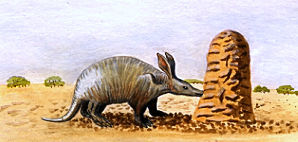Food and feeding
 Aardvarks forage for food only at night and mostly find their food underground. They have bad eyesight, but have excellent senses of smell and hearing, which they use to help find termite nests. They walk in zigzags, sniffing the ground and pointing their ears forwards. Once a nest has been located, aardvarks are ideally equipped for breaking in. They have long, spoon-shaped claws and powerful forelimbs ideally adapted to burrowing into termite mounds and can penetrate nests which could not be broken through by a man using a pickaxe. There are four claws on each front foot and five on each back foot.
Aardvarks forage for food only at night and mostly find their food underground. They have bad eyesight, but have excellent senses of smell and hearing, which they use to help find termite nests. They walk in zigzags, sniffing the ground and pointing their ears forwards. Once a nest has been located, aardvarks are ideally equipped for breaking in. They have long, spoon-shaped claws and powerful forelimbs ideally adapted to burrowing into termite mounds and can penetrate nests which could not be broken through by a man using a pickaxe. There are four claws on each front foot and five on each back foot.
When the nest has been broken into, the aardvark can probe the hole with its snout. The snout is long, and is protected from dust by a fringe of rough bristles. The nostrils close up when the aardvark is burrowing. Aardvarks have thin and sticky tongues up to 45cm long. They are ideal for feeding on ants or termites swarming through a hole in their nest.
The hole in the termite nest is gradually enlarged by the aardvark until it can get its whole body inside the nest, but it will not destroy it in a single visit, preferring to return several nights in a row to feed on the ants or termites. Ants are more plentiful during the wet season, whilst termites are more common in the dry season. However, if food supplies become scarce, aardvarks will sometimes eat fruit, such as the aardvark cucumber, and soft-bodied insects to supplement their diets.
Read More: Keystone Species